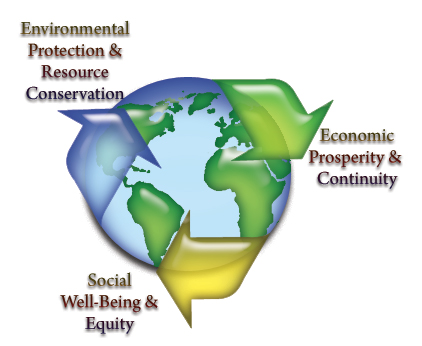The once wholesome term 'sustainable' has long been stolen by the Corporate Sector - aka big business and corporatised government. The term continues to be misused and abused by those employed with communications degrees (aka 'spin doctors') to mean anything they want it to mean.
'Sustainable' has become almost compulsorily used in public relations to justify proposed works that may adversely impact on the natural environment and upon society. In so doing, the proposed works pacify potential detracting 'greenie' and 'socialist' types.
'Sustainability' has become a corporate pseudonym for 'viable' - viable for corporate sustainable profit or government saving money.
So in order to drag the Corporate Sector to social and environmental accountability, it is preferable to instead use the once popular but clearer term 'Triple Bottom Line'.
Triple Bottom Line (TBL) was coined in 1998 by John Elkington:
'An addition of social and environmental values to the traditional economic measures of a corporation or organization's success. Triple Bottom Line accounting attempts to describe the social and environmental impact of an organization's activities, in a measurable way, to its economic performance in order to show improvement or to make evaluation more in-depth.'*
It is much harder to greenwash the defined term 'Triple Bottom Line' than it is 'sustainable'.

'Sustainable Population' or Triple Bottom Line Immigration Policy
In developed countries like Australia, human population size, distribution and demographics are not influenced by organic growth, but in the main are a consequence of government open-door immigration policy. If developed countries, like Australia, applied a Triple Bottom Line test to the performance of immigration policies, then the social and environmental values of those policies would be added to the more traditional economic measures in order to evaluate immigration policy performance.
Currently, the narrow Economic/Accounting (single) Bottom Line approach only considers the economic benefits of immigration. Even then, the measures of economic impact are limited to short term macro-economic metrics such as consumption, GDP and labour force.
Of course more immigrants will demand more so consumption rises, but also demand on public services and environmental resources (such as drinking water) - which are conveniently not reported by government.
Of course more skilled immigrants will plug skills shortages of business and so business grows and GDP rises and tax revenues rise. Plus business and government save money by not having to spend on education and skills training. But this skill matching is inequitable as it displaces and disenfranchises an unskilled local population. Most job growth ignores rural and regional Australia. GDP growth also puts more pressure on environmental resources (such as coal-fired power stations) - such TBL impacts are conveniently not reported by government.
Of course more skilled immigrants will increase the labour force. But why are immigrants (born overseas) over-represented in the public service and in unskilled positions like transport drivers, while Australia's registered unemployment numbers are over 611,000? A domestic social impact of immigrant employment is domestic unemployment.
And how many of the registered unemployed are immigrants? Such Triple Bottom Line impacts are conveniently not reported by government.
Is not immigration policy a economic, social and environmental responsibility of national governments?

Add comment